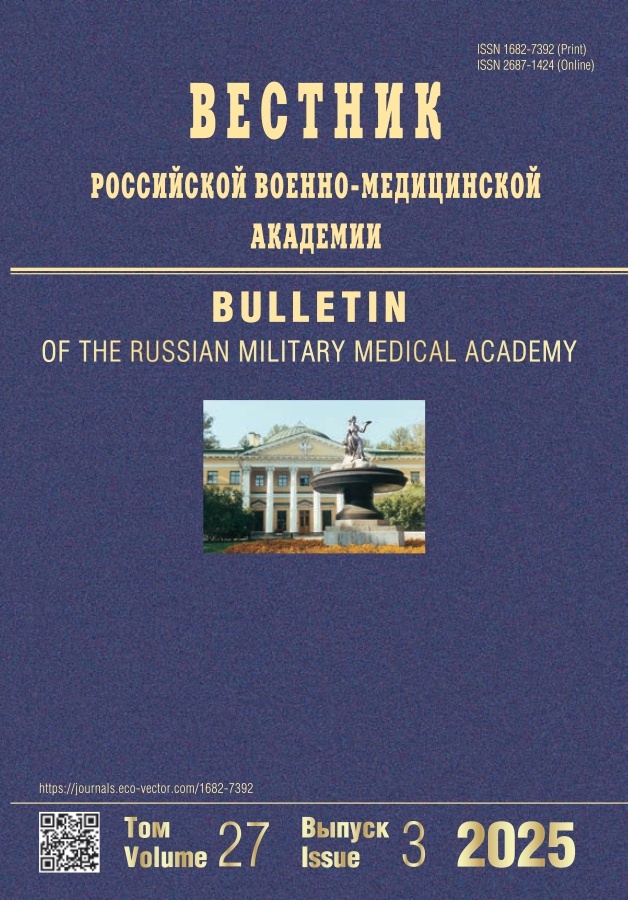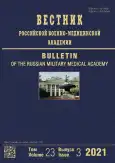Pathophysiological bases of maladjustment formation in high mountains and polar zones
- Authors: Kim A.E.1, Shustov E.B.2, Lemeshchenko A.V.1, Tsygan V.N.1
-
Affiliations:
- Military Medical Academy named after CM. Kirov Ministry of Defense of the Russian Federation
- Scientific and Clinical Center of Toxicology named after acad. S.N. Golikov FMBA of Russia
- Issue: Vol 23, No 3 (2021)
- Pages: 215-222
- Section: Reviews
- URL: https://journals.rcsi.science/1682-7392/article/view/71182
- DOI: https://doi.org/10.17816/brmma71182
- ID: 71182
Cite item
Abstract
The pathophysiological features of the development of maladjustment under mountain-cold conditions as a manifestation of the syndrome of mutual burdening are considered. In this study, contents of various literary sources, characterizing a person’s resistance to the effects of a complex of factors under high mountains and polar zones conditions, were analyzed. With the simultaneous exposure to hypoxia and hypothermia from a pathophysiological point of view, intersecting links of terminological “paths,” often having diametrically opposite dynamics of changes in the characterized concepts, will be significant. Thus, in the terminological mitochondrial “pathway” of energy metabolism, uncoupling proteins are present, which, to increase the resistance to hypothermia, should be activated to switch the energy metabolism to predominantly use fatty acids. However, hypoxic conditions should be suppressed to maintain the level of adenosine triphosphate acid available for cells. In the terminological tract of compensatory reactions in response to hypoxemia, the volume of pulmonary ventilation is released, which must increase to improve tolerance to hypoxia, which, under mountain-cold conditions, increased heat loss and promote the deterioration of the condition, i.e., tolerance to low temperatures. Under hypoxic and hypothermic conditions, a synergistic interaction can form, which can be manifested by the development of a syndrome of mutual burdening, which will result in a significant decrease in the functional capabilities of the body, result, and productivity. Maladjustment to mountain cold, with maximum probability, will manifest as disorders of the central nervous system, decreased physical performance, depletion of the functional and regulatory reserves of the body, functional immunodeficiency, decreased regenerative potential, and development of endogenous intoxication. With a high degree of probability, a significant synergistic interaction of hypoxia and hypothermia can be found in relation to the indicators of pulmonary ventilation, blood gases (hypercapnia), acid–base balance (gas alkalosis and lactic acidosis), heart rate (tachycardia), blood pressure (hypotension), central venous pressure (increase), blood viscosity (increase) and its coagulability (hypercoagulation), peroxide and free radical oxidation (activation), and protein catabolism (increase). These changes will negatively affect the functional state of specialists performing complex professional tasks in polar latitudes.
Full Text
##article.viewOnOriginalSite##About the authors
Aleksey E. Kim
Military Medical Academy named after CM. Kirov Ministry of Defense of the Russian Federation
Author for correspondence.
Email: alexpann@mail.ru
ORCID iD: 0000-0003-4591-2997
SPIN-code: 7148-1566
candidate of medical sciences
Russian Federation, Saint PetersburgEvgeniy B. Shustov
Scientific and Clinical Center of Toxicology named after acad. S.N. Golikov FMBA of Russia
Email: shustov-msk@mail.ru
SPIN-code: 9665-6670
doctor of medical sciences, professor
Russian Federation, Saint PetersburgAleksey V. Lemeshchenko
Military Medical Academy named after CM. Kirov Ministry of Defense of the Russian Federation
Email: lav_1981@mail.ru
ORCID iD: 0000-0001-6786-2332
SPIN-code: 8534-0822
candidate of medical sciences
Russian Federation, Saint PetersburgVasily N. Tsygan
Military Medical Academy named after CM. Kirov Ministry of Defense of the Russian Federation
Email: vn-t@mail.ru
ORCID iD: 0000-0003-1199-0911
SPIN-code: 7215-6206
doctor of medical sciences, professor
Russian Federation, Saint PetersburgReferences
- Majstrah EV. Patologicheskaya fiziologiya ohlazhdeniya cheloveka. Leningrad: Medicina; 1975. (In Russ.).
- Barton A, Edholm O. Chelovek v usloviyah holoda. Fiziologicheskie i patologicheskie yavleniya, voznikayushchie pri dejstvii nizkih temperatur: per. s angl. Moscow: Izdatel’stvo inostrannoj literatury. 1957. (In Russ.).
- Novikov VS, Soroko SI, Shustov EB. Dezadaptacionnye sostoyaniya cheloveka pri ekstremal’nyh vozdejstviyah i ih korrekciya. Saint Petersburg: Politekhnika-prin; 2018. (In Russ.).
- Haskin VV. Energetika teploobrazovaniya i adaptaciya k holodu. Novosibirsk: Nauka; Sib. otd-nie; 1975. (In Russ.).
- Bojko ER. Fiziologo-biohimicheskie osnovy zhiznedeyatel’nosti cheloveka na Severe. Ekaterinburg: Ural’skoe otdelenie RAN; 2005. (In Russ.).
- Novikov VS, Soroko SI. Fiziologicheskie osnovy zhiznedeyatel’nosti cheloveka v ekstremal’nyh usloviyah. Saint Petersburg: Politekhnika-print; 2017. (In Russ.).
- Fricke R. Mechanisms of human cold adaptation. Circumpolar health: Proc. of 8-th symp. Toronto. 2009;8:65–86.
- Cooper KE. Mechanisms of human cold adaptation. Circumpolar Health. University of Toronto Press. 2020;37–46. doi: 10.3138/9781487579876-008
- Berko J, Ingram DD, Shubhayu S. Deaths attributed to heat, cold, and other weather events in the United States, 2006–2010. Natll Health Stat Report. 2014;30(76):1–15.
- van Marken Lichtenbelt WD, Schrauwen P. Implications of nonshivering thermogenesis for energy balance regulation in humans. Am J Physiol Integr Comp Physiol. 2011;301(2):285–296. doi: 10.1152/ajpregu.00652.2010
- Seltenrich N. Between extremes: Health effects of heat and cold. Environ Health Perspect. 2015;123(11):276–280. doi: 10.1289/ehp.123-A275
- Hasnulin VI. Sindrom polyarnogo napryazheniya. III Kaznacheevskie chteniya. Novosibirsk. 2008;26–39. (In Russ.).
- Kulikov VYU, Kim EB. Kislorodnyj rezhim pri adaptacii cheloveka na Krajnem Severe. Novosibirsk: Nauka; 1987. (In Russ.).
- Panin LE. Energeticheskie aspekty adaptacii. Leningrad: Medicina, Leningrad. otdel. 1978. 191 p. (In Russ.).
- Arendt J. Biological rhythms during residence in polar regions. Chronobiol. Int. 2012;29(4):379–394. doi: 10.3109/07420528.2012.668997
- Zinchenko VP, Meshcheryakov BG. Bol’shoj psihologicheskij slovar’. 4-e izd. Saint Petersburg: Prajm-Evroznak; 2009. (In Russ.).
- Metodologicheskie i metodicheskie problemy kontent-analiza. Tezisy dokladov. Vyp. 1,2. Saint Petersburg: [b.i.]; 1973. (In Russ.).
- Luk’yanova LD. Signal’nye mekhanizmy gipoksii. Moscow: RAN; 2019. (In Russ.).
- Novikov VS, Karkishchenko VN, SHustov EB. Funkcional’noe pitanie cheloveka pri ekstremal’nyh vozdejstviyah. Saint Petersberg: Politekhnika-print; 2017. (In Russ.).
- Buryh EA. Obshchie zakonomernosti i individual’nye osobennosti integrativnogo otveta organizma cheloveka na vozdejstvie ostroj normobaricheskoj gipoksii: аvtoref. diss. doktora med. nauk. Saint Petersberg: Institut evolyucionnoj fiziologii i biohimii im. IM. Sechenova RAN. 2020. (In Russ.).
- Nishi Y, Gagge AG. Physical indices of the cold environment. Ashrae J. 2002;1:47–51.
- Van Lir E, Stiknej K. Gipoksiya. Moscow: Medicina; 1967. (In Russ.).
- Eryuhin IA, SHlyapnikov SA. Ekstremal’noe sostoyanie organizma. Elementy teorii i prakticheskie problemy na klinicheskoj modeli tyazheloj sochetannoj travmy. Saint Petersburg: Eskulap; 1997. (In Russ.).
- Sokolov VA. Mnozhestvennye i sochetannye travmy. Moscow: GEOTAR-Media; 2006. (In Russ.).
- Kryukov E.V. Izmeneniya nespecificheskoi zaschiti i immuniteta u voennoslujaschih v processe adaptacii k voennoi slujbe. Voenno-medicinskii jurnal. 2003;324(12):60–61. (In Russ.).
- Кryukov E.V. Izmeneniya perekisnogo okisleniya lipidov i gemostaza u voennoslujaschih v processe adaptacii k voennoi slujbe. Voenno-medicinskii jurnal. 2003;324(11):72–73. (In Russ.).
Supplementary files








